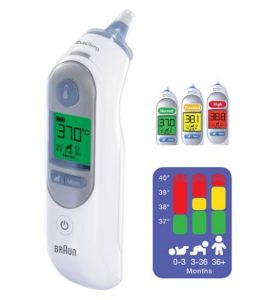All parents worry that their children would get a fever, especially during the cold and flu season. They are even more worried if the fever lasts for more than a couple hours- or worse- days. When children get a fever, they become more tired, they lose their appetite, and become very cranky. All of this makes parents more worried and anxious. To fight the fear of fever, Dr. Rania Hawayek will guide us through answering all the questions on fever and how to deal with it.
The Common Question: What is a fever?
Fever is a rise in the body’s temperature. It is the body’s way of reacting to a certain condition like an infection. The normal body temperature is 37.2 Celsius, but it can differ depending on the child’s age, and the way you take their temperature.
Here is a quick guide based on different age groups:
– For babies from birth to 3 months old: A fever is a core temperature of 38 degrees C and above.
– The age group of 3 months and 3 years: A fever is a core temperature of 39 degrees C and higher.
– For children older than 3 years and adults: A fever is a core temperature higher than 39.5 degrees C.
Causes of Fever
The most common cause of a fever is an infection. These are usually viral infections, such as the common cold. And the very first signs of a cold are:
– a runny nose.
– a sore throat.
– sneezing and mild cough.
– raised temperature, which may last for about 2 to 4 days and recedes on its own.
Other common viral infections which cause fever are “tummy bugs”, or coughing. There are a few illnesses which cause rashes as well, such as hand, foot and mouth disease or roseola.
Whenever a fever is accompanied by these viral symptoms, there is far less need for concern. We should simply manage the fever with fever-reducing medications such as paracetamol or ibuprofen. We should also keep the child well-hydrated and well-rested. There are also some home remedies that help in these cases; these will be discussed in more detail in the next part.
If the fever persists beyond 3 to 4 days or you don’t know what is causing it, we recommended consulting with your doctor. A pediatrician will help you understand any hidden causes, such as:
– a middle ear infection
– tonsillitis infection
– urine infection.
If it was one of the previous, then you will need to treat it with antibiotics in order to bring down the fever.
We are now at the beginning of the flu season.
Influenza is a viral illness which causes significant cold-like symptoms, as well as a very high fever. If caught within the first 48 hours, it can be treated by antiviral medication to shorten the duration of the illness, the severity of the symptoms and the risk of complications.
Measuring Temperature
There are a few ways to take your child’s temperature.
1| A rectal thermometer
You can use it to take babies’ temperature from birth to 3 months old. Many people would agree that it is the most accurate way to take an infant’s temperature.
2| An ear thermometer
Most parents prefer ear thermometers. This measurement is very close to the body’s core temperature (around 0.5 degrees C lower). I recommend using this method from birth up to three years.
3| an oral thermometer
For older children, an oral thermometer is best. Place it under your child’s tongue for an accurate measurement.
But nothing is set in stone. I still find myself using an ear thermometer on my older patients, as well as my own children, as it’s quicker and easier.
Keep in mind external environment
A very important point to remember is that a baby’s temperature varies greatly according to the external environment. Babies up to 3 years old tend to absorb significant heat from their environment and can equally lose a lot of heat to their environment. This can give false readings of temperatures that are too high or too low.
If you happen to feel that your baby is warm but otherwise seems well, here is what we suggest. Take your baby’s temperature, and then take off some layers of your baby, and lay him or her down for a few minutes. Measure the temperature again after 10 minutes or so. You’ll often find that you now get a more true reading which is closer to normal.
Treating A Fever
If your child has a low-grade fever (37.5 to 38.5°) alongside obvious symptoms of a cold, and seems well, you don’t need to turn to medications immediately. This temperature raise is your child’s body’s defenses against the infection. If the fever is higher and is accompanied by symptoms of tiredness and pain, it is completely reasonable to give your child something to help reduce it. As mentioned before, the two most common medications used to treat fevers are paracetamol and ibuprofen. Paracetamol can be given every 4 to 6 hours, up to 4 times a day. Ibuprofen every 6 to 8 hours, up to 3 times a day.
Most fevers can be managed with paracetamol alone. But often, a fever comes back too soon (within 4 hours) to give the second dose of paracetamol; this is where alternating the two medications helps.
Should I put socks on baby with fever?
As mentioned previously, children’s temperature is more affected by exterior environments. Therefore, any method that increases heat loss through their skin can effectively bring their temperature down. If your child has a high fever with cold hands and feet, do not cover them up with blankets or put socks on. This will heat them up further and may lead to even higher fevers and that may lead to dehydration or even febrile convulsions.
Putting the child in a tepid bath helps them feel warm, while at the same time their core temperature drops due to a better distribution of their blood volume, as well as evaporation of bath water off their skin. If you happen to find your child with a significantly high fever, I suggest you give them a dose of medication and put them in the bath while it starts to take effect.
Other home remedies that have a similar effect are tepid sponging. Sponging with a mixture of vinegar and water is also used in some households. This does seem to work, most likely due to the low evaporation temperature of the vinegar; it absorbs heat from the skin to evaporate, leaving the skin cooler.
Repercussions of Fever
Fevers are not always dangerous. Dehydration is what we most fear when having a fever. A child whose body is at a higher temperature than usual is losing more fluids through sweating and evaporation.
Other parents fear seizures which happens when higher temperatures temporarily change the electrical impulses in the brain. This causes seizure-like movement and symptoms. Seizures, or febrile convulsions, are common amongst some children. If a child gets one, then he or she is at risk of getting more.
Do note that this is not related to epilepsy and does not increase the risk of epilepsy in the future. For parents with children who get this condition, I usually advise that they monitor their temperatures closely and treat at lower readings than what we usually recommend.
Prevention & Cure
Preventing fever starts by preventing and protecting our children from catching infections. But this is easier said than done.
Certain infections like polio, rubella, and chickenpox have vaccines against them. So if we plan a vaccination schedule with our pediatrician, it will prevent catching infections, and fevers.
However, we can’t prevent some viruses like the common cold. What we can do is protect our children from catching them, and take the right precautions. But, if your children begin to develop symptoms, then it is best to use the previous methods.
With the recurrent infections and illnesses that our children are exposed to from the day they are born, fever becomes a very common symptom that parents have to deal with. The majority of fevers are not dangerous and are easily explained and managed. However, there are a few cases where fevers need further assessment and investigation by a pediatrician, especially in the case of babies under the age of 3 months and in those even older, with very few or no other symptoms.
I hope this article will help first-time mum and dads to assess their children’s temperature and take the necessary measures to cure and prevent them. We’ll be taking a closer look in my next post, till then have a great day!








Awesome post! Join the fun at https://sugongfang.com for up to R$1,000 welcome bonus, progressive jackpots, and instant PIX withdrawals. Date: 2025-10-27 20:51:05 (-03).
好文!2026年世界杯越来越近了,让我们共同期待这场全球足球盛宴。日期:2025-11-18 19:36:55 (-03)。
Awesome post! Join the fun at https://motagascassino.com for up to R$1,000 welcome bonus, progressive jackpots, and instant PIX withdrawals. Date: 2025-11-20 01:42:45 (-03).
Awesome post! Join the fun at https://denemebonusufreebet.com for up to R$1,000 welcome bonus, progressive jackpots, and instant PIX withdrawals. Date: 2025-11-27 00:56:28 (-03).
Awesome post! Join the fun at https://brx-owhatsapp.com 使用 WhatsApp 网页版,发送语音消息让您的沟通更加生动。 . Date: 2025-12-01 18:11:01 (-03).